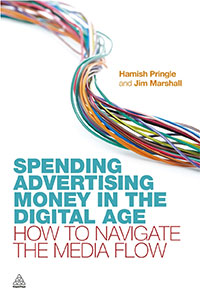Harnessing media power |
 |
| John Fanningn a valuable new book on how to maximise the new mediascape |
We are now so dependent on communicating through email, acquiring information through the internet and blathering on social media networks that we quickly forget how recent all these developments are; emails only became common less then 15 years ago. The resulting seismic changes in the marketing communications media landscape have not yet been fully grasped and the revolution has still not run its course.
A new book, Spending Advertising Money in the Digital Age, by Hamish Pringle and Jim Marshall, is as good a guide as you are likely to get to the implications, opportunities and pitfalls of the new communications era. Perhaps the most welcome feature of the book is that it puts this new era in a historical perspective and discusses the relationship between what it describes as traditional media and the new internet based channels.
Far too much comment on the digital age is characterised by what one commentator described as creeping barbarism where past knowledge is dismissed as irrelevant by proponents of perpetual change. Even the very title of this book acknowledges the relevance of the past borrowing from Simon Broadbents seminal Spending Advertising Money, first published in the 1970s and subsequently in multiple editions.
Pringle is the former director general of the Institute of Practitioners in Advertising (IPA) with over 26 years advertising experience. He ran his own branding and marketing agency and worked for a number of agencies, including Saatchi & Saatchi. Marshall is chief client servicesd officer for Aegis and has over 35 years experience in media, as a director at Young & Rubicam (Y&R), Reeves Robertshaw and later at DMB&B.
The authors argue that the media industry has gone through two waves of evolution, the dominance of newspapers up to the 1960s, followed by the dominance of TV to the turn of the century and that we are now entering a third wave which will dominated by digital.
They give ample space to the resulting changes in the marketing communications landscape, paying particular attention to the separation of creative agencies and media independents and although they seem to suggest that the proliferation of communication channels made possible by the digital age might result in a coming together of the planning, creative and media disciplines, they predict it wont happen.
Rather they predict the media agencies may become more closely aligned with direct marketing and web design agencies. This brings up the thorny question of which comes first, the channel or the creative egg? Ive always maintained that the latter must come first but this book makes a persuasive case for giving automatic precedence to neither. Instead, we must now consider the creative content and the media content equally and decide what to say and where to say it after discussing the merits of each case.
The book makes it clear that in spite of the digital changes the UK (and Irish) media scene is still dominated by traditional media but the proliferation of media options means that more options must be considered. The authors conducted an analysis of the winning entries in the IPAs Advertising Works series and show that in 1980 the number of media options listed was nine, compared to 20 in 2010 and that the average number of media options used by the winners was 2.4 in 1980 compared to 9.18 in 2010.
But TV was still the dominant media in 2010 used by 92 per cent of winners. They conclude that the most effective campaigns in future will require a multi-media, multi-platform strategy and execution and even provide a new five part model for media planning FIAPA, Fame – awareness, salience; Information- the factual details; Advocacy – testimonials, reviews, word-of-mouth; Price – cost with special offers tailored to individuals and Availability – online and offline.

A sane, balanced, comprehensive and though-provoking book John Fanning
The most important concept discussed in the book is that people and brands now live lives that are intertwined with the media flow, the life flow is becoming inextricable linked to the media flow, for centuries media have touched peoples lives but only at certain times; however nowadays their ubiquity, accessibility and utility have made them an integral part of peoples existence. This is a critical insight the implications of which are only beginning to emerge. One immediate one is how to measure peoples exposure to the new media landscape and the authors pay full tribute to the IPAs TouchPoints survey which was launched in 2006 and appears to have achieved that objective. One can only wonder how long we in Ireland can be without a similar exercise.
This is a sane, balanced, comprehensive and thought-provoking book which should be essential reading for everyone, not just media folk, involved in the marketing communications business; everyone involved in advertising should have an understanding of media and how it can most effectively be used in navigating a brand into the target consumers life flow.









